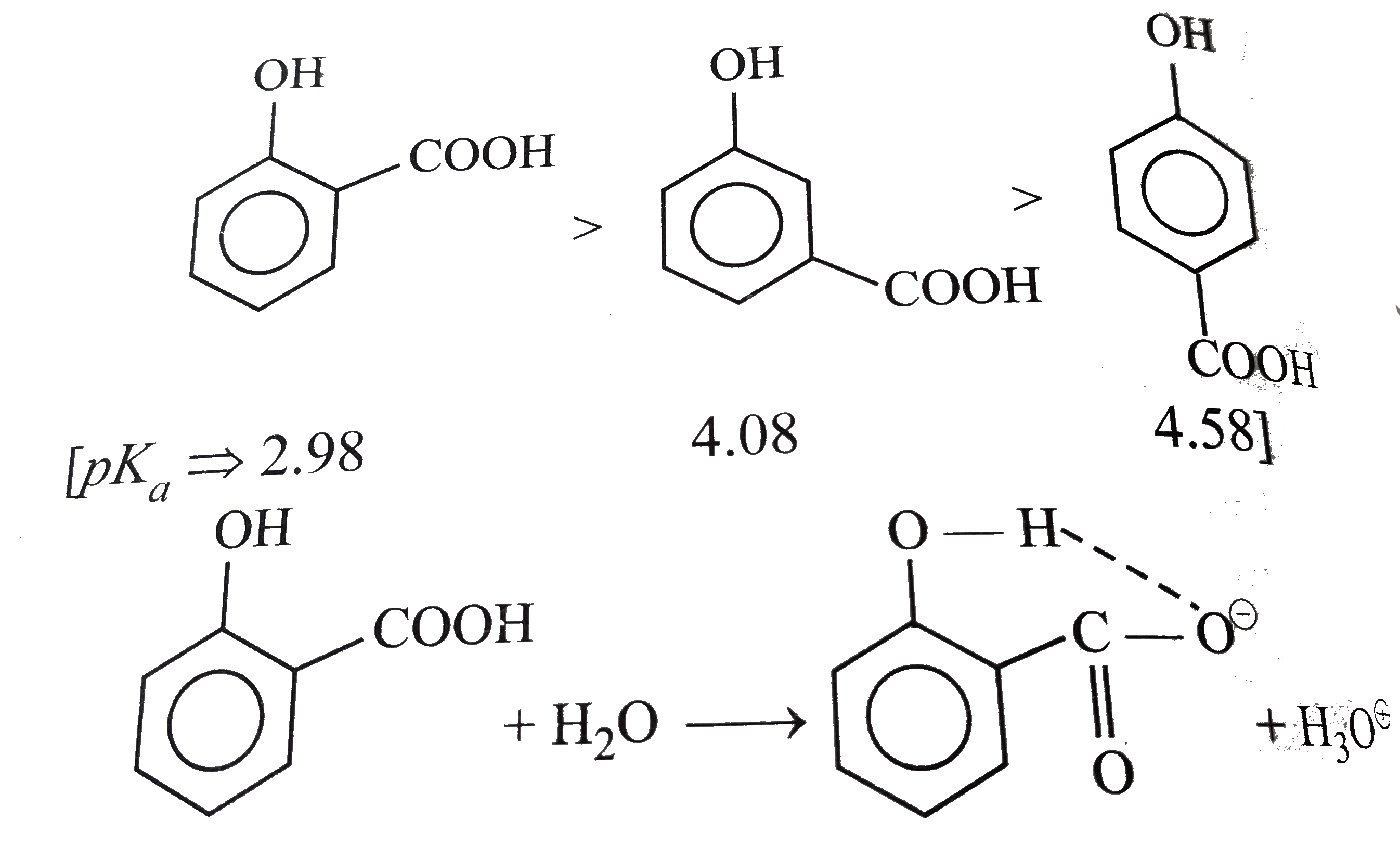(a) Nitrogen and chlorine have almost same EN' s but N forms H-bonding
(a) Due to the large size of CI interacting with neighbouring molecules is not so strong
(b) In H2O there are stron intermolecular forces due to extensive H-bonds No such bonding exists in H2S since EN of O>EN of S
(c ) Stregth of certain acids and bases can be explained on the basis of H-bonding The abnormally high ka or low pKa value of o-hydroxybenzoic acid is due to the fact that the conjugate base is stabilised by h-boding Decreasing acidic strength order is ltbr> (d) The size of N atom is less than the size of CIatom therefore electron density in N is more than that of CI So N forms H-bonding leading to association of molecule Hence NH3 is liquid H-bonding is not possible with CI
(e) HF due to maximum EN of F Decreasing order of strength of H-bonding
HF>NH3>CH3COOH (exist as dimer) gt CH4
(f ) HF and CH3OH
 .
.
Topper's Solved these Questions
- CHEMICAL BONDING AND MOLECULAR STRUCTUREBOOK - CENGAGE CHEMISTRY ENGLISHCHAPTER - CHEMICAL BONDING AND MOLECULAR STRUCTUREEXERCISE - Solved Examples
36 Videos
- CHEMICAL BONDING AND MOLECULAR STRUCTUREBOOK - CENGAGE CHEMISTRY ENGLISHCHAPTER - CHEMICAL BONDING AND MOLECULAR STRUCTUREEXERCISE - Ex 2 .2 Subjective (Intermolecular Forces And H-Bonding)
7 Videos
- ATOMIC STRUCTUREBOOK - CENGAGE CHEMISTRY ENGLISHCHAPTER - ATOMIC STRUCTUREEXERCISE - Concept Applicationexercise(4.3)
19 Videos
- CHEMICAL EQUILIBRIUMBOOK - CENGAGE CHEMISTRY ENGLISHCHAPTER - CHEMICAL EQUILIBRIUMEXERCISE - Subjective type
1 Videos
Similar Questions
Give reasons for the following:
Molecules of hydrogen and chlorine have single covalent bonds between their atoms while oxygen has a double covalent and nitrogen a triple covalent bond respectively.
View SolutionThe electronegativity of both nitrogen and chlorine is the same. But nitrogen is inert at room temperature whereas chlorine is highly reactive
View SolutionWhy does the percentage of gases like oxygen, nitrogen and carbon dioxide remain almost the same in the atmosphere?
View SolutionName the compounds that have a high nitrogen to carbon ratio and are transported form of nitrogen in some plants.
View SolutionBoth NH3andNF3 have identical shapes and same state of hybridisation. Both N-H and N-F bonds have almost the same electronegativity difference. But still, the two molecules have different dipole moment values. How will you account for it ?
View SolutionStatement I : The energy of a He+ ion for a given n is almost exactly four times that of H atom for the same n.
Statement II : Photon emitted during transition between corresponds pair of levels in He+ and H have the same energy E and the same wavelength λ=hc/E.
View SolutionChlorine oxidises H2S to
View SolutionWhich statement is correct for ionic bond?
(a) It is non-directional .
(b) It is not formed by overlapping of orbitals
(b) It is formed by overlapping of orbitals.
(c ) it is formed by the elements with same EN
(d) Both (a) and (b) are correct .
View SolutionNitrogen forms the largest number of oxides as it is capable of forming stable multiple bonds with oxygen. They range of N2O (O.S of nitrogen +1) through NO,N2O3,NO2,N2O4 "to" N2O5 (O.S of nitrogen +5). Following points are improtant regarding the study of oxides of nitrogen.
(a) All oxides of nitrogen expect N2O5 are endothermic as a large amount of energy is required to dissociate the stable molecule of oxygen and nitrogen.
(b) The small electronegativity difference between oxygen and nitrogen make N-O bond easily breakle to give oxygen and hence oxides of nitrogen are said to be better oxidising agents.
(c) Expect N2O5, all are gases at ordinary temperature. N2O3 is stable only at lower temperature (253K).
(d) Expect N2O and NO which are neutal oxides, all are acidic oxides which dissolve in water forming coresponding oxy acids.
(e) They are also good example for illustrating the concept of resonance.
The gas which is acidic in nature is :
View SolutionIf the central atom is of third row or below this in the periodic table, then lone pair will occupy a stereochemically inactive s-orbital and bonding will be through almost pure p-orbitals and bond angles are nearly 90∘, if the substituent's electronegativity value is ≤2.5.
In which of the following option, covalent bond is having maximum s% character ?
View Solution
